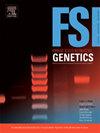来自巴尔干半岛不同地区的塞尔维亚人群中 Y 染色体单倍群 I-P37.2 的系统地理学。
IF 3.2
2区 医学
Q2 GENETICS & HEREDITY
引用次数: 0
摘要
当代塞尔维亚人口的遗传结构是由长期动荡的历史和人口事件形成的。在近代史上,最重要的塞族人迁徙到今天的塞尔维亚,发生在 15 至 18 世纪,来自老黑塞哥维那、科索沃和梅托希亚地区。以前的单倍群分析显示了广泛的主要单倍群,其中单倍群 I-P37.2 是来自巴尔干半岛的塞尔维亚人群体中最常见的单倍群。在这项研究中,使用 22 个 Y 单核苷酸多态性(Y-SNPs)对来自巴尔干半岛塞族人居住的三个地区(现塞尔维亚、旧黑塞哥维那地区、科索沃和梅托希亚地区)的 464 个塞族男性样本进行了基因分型,以便对单体组 I-P37.2 进行更深入的系统发育和系统地理分析。根据 SNP 分型,旧黑塞哥维那和现今塞尔维亚数据集中的所有样本以及科索沃和梅托希亚 128 个样本中的 122 个样本被归入单倍群 I-L621。进一步的 SNP 分型显示,所有数据集的单倍群分布非常相似,最主要的单倍群是 I-PH908,其次是单倍群 I-Z17855。在单倍群 I-PH908 中进行的分析表明,单倍群 I-FT14506 在科索沃和梅托希亚数据集中最为常见,而单倍群 I-FT16449 在老黑塞哥维那数据集中最为常见。在今天的塞尔维亚数据集中,单倍群 I-FT14506 和 I-FT16449 的出现率几乎相等,分别为 40.2% 和 34.4%。在单倍群 I-PH908 中,所有数据集之间的分化程度都很低,现今塞尔维亚和老黑塞哥维纳数据集之间的分化程度最低,科索沃和梅托希亚与老黑塞哥维纳数据集之间的分化程度最高。此外,中位连接网络分析和共享单倍型统计显示,老黑塞哥维那和当今塞尔维亚单倍型之间的遗传关系更为密切。这项研究的结果支持这样的论点,即从老黑塞哥维那历史区域和科索沃与梅托希亚地理区域的移民对当今塞尔维亚人口的遗传结构有很大的影响。此外,本文介绍的结果使人们深入了解了检测到的单倍群 I-Z17855、I-Y4460、I-PH908、I-Y5596、I-Y4882、I-FT14506、I-FT16449 和 I-A5913 以及分析的 SNPs 的地理分布情况,从而进一步提高了父系祖先推断的地理分辨率。本文章由计算机程序翻译,如有差异,请以英文原文为准。
Phylogeography of Y-chromosome haplogroup I-P37.2 in Serbian population groups originating from distinct parts of the Balkan Peninsula
Genetic structure of the contemporary Serbian population was shaped by a long history of turbulent historical and demographical events. The most important migrations of Serbs towards present day Serbia, in the recent history, occurred between the 15th to the 18th century from the regions of Old Herzegovina and Kosovo and Metohija. Previous haplogroup analysis revealed wide spectrum of main haplogroups, among which haplogroup I-P37.2 was the most frequent one in Serbian population groups originating from the Balkan Peninsula. Within this study 464 Serbian males samples from three geographical regions in the Balkan Peninsula inhabited by Serbs: present-day Serbia, regions of Old Herzegovina and Kosovo and Metohija, previously classified as haplogroup I-P37.2, were genotyped using the 22 Y-single nucleotide polymorphisms (Y-SNPs) in order to determine deeper phylogenetic and phylogeographic analysis of haplogroup I-P37.2. Based on SNP typing all samples in the Old Herzegovina and present-day Serbia dataset and 122 out of 128 samples from Kosovo and Metohija were assigned to haplogroup I-L621. Further SNP typing revealed very similar haplogroup distribution in all datasets, with the predominant haplogroup being I-PH908, followed by haplogroup I-Z17855. Analysis within haplogroup I-PH908 distinguished haplogroup I-FT14506 as the most frequent in the Kosovo and Metohija dataset, while haplogroup I-FT16449 was the most frequent in the Old Herzegovina dataset. In the present-day Serbia dataset, occurrence of haplogroups I-FT14506 and I-FT16449 was almost equal, comprising 40.2 % and 34.4 %, respectively. Low level of differentiation, within haplogroup I-PH908, was detected between all datasets, with the lowest one detected between present-day Serbia and Old Herzegovina datasets and highest one between Kosovo and Metohija and Old Herzegovina datasets. Furthermore, median-joining network analysis and shared haplotypes statistics revealed closer genetic relationship between Old Herzegovina and present-day Serbia haplotypes. Results obtained within this study support the thesis that migrations from historical region of Old Herzegovina and geographical region of Kosovo and Metohija, had great contribution on the present-day Serbian population genetic structure. Furthermore, here presented results, gave insight into geographic distribution of detected haplogroups I-Z17855, I-Y4460, I-PH908, I-Y5596, I-Y4882, I-FT14506, I-FT16449 and I-A5913 and analyzed SNPs, enabling further improvement of the geographic resolution of paternal ancestry inference.
求助全文
通过发布文献求助,成功后即可免费获取论文全文。
去求助
来源期刊
CiteScore
7.50
自引率
32.30%
发文量
132
审稿时长
11.3 weeks
期刊介绍:
Forensic Science International: Genetics is the premier journal in the field of Forensic Genetics. This branch of Forensic Science can be defined as the application of genetics to human and non-human material (in the sense of a science with the purpose of studying inherited characteristics for the analysis of inter- and intra-specific variations in populations) for the resolution of legal conflicts.
The scope of the journal includes:
Forensic applications of human polymorphism.
Testing of paternity and other family relationships, immigration cases, typing of biological stains and tissues from criminal casework, identification of human remains by DNA testing methodologies.
Description of human polymorphisms of forensic interest, with special interest in DNA polymorphisms.
Autosomal DNA polymorphisms, mini- and microsatellites (or short tandem repeats, STRs), single nucleotide polymorphisms (SNPs), X and Y chromosome polymorphisms, mtDNA polymorphisms, and any other type of DNA variation with potential forensic applications.
Non-human DNA polymorphisms for crime scene investigation.
Population genetics of human polymorphisms of forensic interest.
Population data, especially from DNA polymorphisms of interest for the solution of forensic problems.
DNA typing methodologies and strategies.
Biostatistical methods in forensic genetics.
Evaluation of DNA evidence in forensic problems (such as paternity or immigration cases, criminal casework, identification), classical and new statistical approaches.
Standards in forensic genetics.
Recommendations of regulatory bodies concerning methods, markers, interpretation or strategies or proposals for procedural or technical standards.
Quality control.
Quality control and quality assurance strategies, proficiency testing for DNA typing methodologies.
Criminal DNA databases.
Technical, legal and statistical issues.
General ethical and legal issues related to forensic genetics.

 求助内容:
求助内容: 应助结果提醒方式:
应助结果提醒方式:


